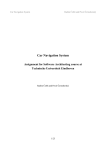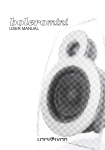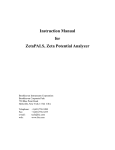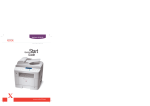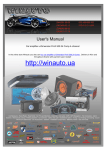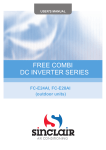Download Bosch WAS20160UC/23 Operating instructions
Transcript
y Safety instructions Moisture in the drum is due to end inspection. Scope of delivery – The washing machine is heavy - lift with caution. – Frozen hoses can tear/burst. Do not install the washing machine outdoors or in an area exposed to freezing conditions. – These installation instructions are intended for use by qualified installers. In addition to these instructions, if installing the washing machine: In the United States comply with the National Electric Code, ANSI/NFPA70 - latest edition/State and municipal and/or local regulations. In Canada comply with the Canadian Electric Code C22.1 - latest edition/provincial and municipal and/or local regulations. – If the washing machine is located in a room which will be exposed to temperatures below freezing, or if it is located in a cabin that is being shut down for the winter, any residual water in the pump or water inlet hose(s) must be drained. – Take care not to damage the washing machine. Do not hold on to protruding parts (e.g. door) when lifting. – In addition to the safety information listed here, the local water end electricity supplier may have special requirements. – If in doubt, have the appliance connected by an authorized technician. Standard Power cord Water supply hoses Drainage hose Water connection l – The washing machine must only be operated with cold and hot (max. 140 °F/60°C) tap water. Do not connect the appliance to the mixer tap of an unpressurized hot-water boiler. – To prevent water damage, the hot and cold water valves should be accessible when the washing machine is in place and should always be turned off when the washing machine is not in use! – If installing the washing machine in a new building or a building in which the plumbing system was recently installed or upgraded, flush the lines before installing the washing machine to remove any sand, dirt or residue. – The connection points are under full water pressure. Check seal with tap fully open. – To prevent leakage or water damage, follow the instructions in this chapter! – Do not use a used inlet hose. Only use the inlet hose supplied or one which was purchased from an authorized dealer. – If in doubt, have the appliance connected by a technician. – Before first use be sure to completely remove the 4 shipping locks and keep them. – All four hose guides need to be installed to prevent access to moving parts. – For later shipping be sure to reinstall the shipping locks - prevents damage to the machine a Page 6. – Save screws and sleeves. 1. Take the hoses out of the holder and the elbow. Remove elbow. Water supply Wrench Water inlet hose: Covers with hose holders Proper disposal – All packaging materials are non-polluting and recyclable. Please contribute to a better environment by disposing of packaging materials in environmentally friendly manner. Please ask your dealer or local authority about the best means of disposal. Old appliances are not worthless rubbish. Valueable raw materials can be reclaimed from environmentally friendly recycling. Removing shipping locks Attention: Do not kink, crush, modify or cut through (strength is no longer guaranteed). Optimum water pressure should be between: 14.5 to 145 p.s.i. (1-10 bar) – When the tap is turned on, the water flow is at least 2.2 U.S. gallons (8 liters) per minute. – If the water pressure is higher, install a pressure reducing valve. Elbow for fixing the waste water hose 2. Loosen and remove all 4 transportation protection devices. 1. Connect water supply hoses to the taps. Additionally needed depending on connection 2. Carefully turn on the taps and check the connection Useful tool Installation surface points are not leaking. Attention: screw connection is under water mains pressure. – Level for alignment. 3. Take the power cord out of the holders. Remove sleeves. – Stability is important to that the machine does not "walk"! – The installation surface must be solid and level. – Soft floors/floor coverings are not suitable. Hose and cable lengths or Left-side connection For installation on a base Right-side connection – Fasten the washing machine feet with retaining tabs* (*Order no. WMZ 2200, WX 9756). Water drainage For installation on a wooden joist floor Water drainage hose: 4. Fit the covers. Lock securely by pressing on the locking hook! – Install the washing machine in a corner if at all possible. – Screw a waterproof wooden plate (min. 1.18 in. thick) on the floor. – Fasten the washing machine feet with retaining tabs* (*Order no., see above). 3/4” Tighten plastic screw-fittings by hand only. – 1 hose clamp Ø 0.94 in.-1.57 in. (commercially available) for connectiong to siphon a Page 4; Water connection. 51 in. 41 in. Attention: Do not kink or stretch. Height difference between installation area and outlet: 0 - max. 39 in. 47 in. 28 in. Drainage into a sink/bath tub: Attention: Secure the drainage hose to prevent it from slipping out of the sink. Attention: The plug must not be in the plug hole. When the water is being pumped out of the washing machine, check that the water drains away quickly enough. Do not insert the end of the drainage hose into the pumped off water! There is a risk that water will be drawn back into the washing machine! max. 39 in. Under-counter/closet installation of the machine Under-counter / in-cabinet installation before connecting to power supply. 37 in. Installation in kitchen cabinets (under-counter or in-cabinet) – Cubicle width of 23.62 in. is required. – Only install the washing machine under a continuous counter top which is securely fastened to the neighboring cabinets. – If installing the washer in a closet, observe the minimum distances: Side: 0 in., rear: 1.97 in., top: 0 in., front: 2.76 in. 55 in. Drainage into a siphon: Attention: Secure connection point with hose clip, Ø 0.9 in. - 1.6 in. (dealer). Note: When using the hose holder, possible hose lengths are reduced! Available commercially or from customer service: – Longer supply hose (approx. 86.61 in.), for standard model. . 5. Fix hoses in the hose holders. Fit the hose clips. Drainage into a standpipe or in wall installation: Use the U-bracket. Attach the U-bracket to the end of the hose and insert end of hose into standpipe or wall drain. Use a strap or cable tie connected to U-bracket to hold hose in place. 1 2 3 4 Alignment Strong odor, vibrations and "walking" can be the result of incorrect alignment! Transportation, e.g. if moving house Customer Service 1. Before transporting the washing machine: ʑ Align washing machine with a level 1. Turn off the tap. 2. Release the water pressure In the supply hose. a Operating instructions, Page 9; Filter In the water supply. 3. Drain any residual detergent solution. a Operating instructions, Page 9, Detergent solution pump. 4. Isolate the washing machine from the power supply. 5. Remove the hoses. 1. Loosen counter nut with wrench counterclockwise. 2. Change height by turning the machine feet. All four machine feet must stand firmly on the floor The washing machine must not rock! Check alignment of the washing machine with level and correct if necessary. 2. ʑ ʑ If you cannot resolve a problem by yourself a Operating instructions: Troubleshooting, page 12/13, please contact our Customer Service. We will always find the right solution and can even help you avoid an unnecessary service call. You will find the contact information for your nearest Customer Service here or in the Customer Service directory (depending on model). When contacting Customer Service, please provide the Model Number and Serial Number of the appliance. Model Number Installing transportation protection devices: ʑ 1. Remove the covers. Washing machine Serial Number You will find this information in the following locations: On the inside of the loading door* / service cover when open* and on the back of the appliance. Put your trust in the manufacturer's expertise. By consulting us, you can rest assured that your appliance will be repaired by trained service technicians using only original replacement parts. Installation instructions ʑ ʑ ʑ ʑ ʑ ʑ ʑ ʑ This appliance must be grounded. In the event of a malfunction or breakdown, grounding will reduce the risk of electrical shock by providing a path of least resistance for the electric current. This appliance features a cord with an equipment-grounding conductor and a grounding plug. The plug must be plugged into an appropriate outlet which has been properly installed and grounded in accordance with all local regulations and ordinances. Improper connection of the equipment grounding conductor may result in electric shock. Have the appliance checked by a qualified electrician or service technician if you are in doubt as to whether the washer has been properly grounded. Do not modify the plug provided with the appliance - if it will not fit in the outlet, have a proper outlet installed by a qualified electrician. The washing machine must only be connected to an individual branch circuit via a socket which has been properly installed and grounded. The household electrical voltage must correspond to the voltage specifications on the washing machine. Connection specifications as well as the required fuses are stipulated on the appliance rating plate. Volts: 208 - 240; Hertz: 60; Amperes: 12 0110 / 9000534780 Electrical connection *534780* 3. Tighten the counter nut against the housing. – Hold the feet while doing this and do not change the height. The counter nuts of all four machine feet must be screwed tightly against the housing! Make sure that: – the power plug fits into the socket. – the wire size is sufficient. – the grounding system is properly installed: The power cord may be replaced by an electrician only. Replacement power cords are available from Customer Service. To reduce the risk of fire or electrical shock, DO NOT use an extension cord or an adapter to connect the washing machine to the power supply. If a ground fault circuit breaker is to be used, only use types marked with the following symbol: ‚. Only this symbol can guarantee compliance with all current regulations. Electrical plug: – do not insert/pull out of the socket with damp hands. – do not pull the plug out of the socket by tugging the power cord. – Never pull out the plug while the appliance is operating. Manufacturer a Operating instructions 5 2. Insert all 4 sleeves. Clamp the power cord into the holders. Insert the screws and tighten. Contents ʋ ʋ ʋ ʋ ʋ ʋ ʋ ʋ ʋ ʋ ʋ ʋ ʋ The transportation protection devices must be removed after transportation! a Page 3. To prevent unused detergent from flowing Into the outlet during the next wash: Pour 1 litre of water into dispenser II and start the Empty programme. Technical specifications ʑ ʑ ʑ ʑ Dimensions (width x depth x height) 23.6 x 23.2 x 33.2 in. Weight 169.8 lbs Power supply Nominal voltage 208-240 V, 60 Hz Nominal current 12 A Water pressure 14.5 to 145 p.s.i. (1-10 bar) Safety instructions . . . . . . . . . . . . . . . . . . Proper disposal . . . . . . . . . . . . . . . . . . . . Installation surface. . . . . . . . . . . . . . . . . . Under-counter and in-cabinet installation Scope of delivery. . . . . . . . . . . . . . . . . . . Hose and cable lengths . . . . . . . . . . . . . Removing shipping locks . . . . . . . . . . . . Water connection . . . . . . . . . . . . . . . . . . Alignment . . . . . . . . . . . . . . . . . . . . . . . . Electrical connection . . . . . . . . . . . . . . . . Transporting, e.g. when moving . . . . . . . Technical specifications. . . . . . . . . . . . . . Customer Service . . . . . . . . . . . . . . . . . . . . . . . . . . . . . . . .. .. .. .. .. .. .. .. .. .. .. .. .. Page ..1 ..1 ..1 ..1 ..2 ..2 ..3 ..4 ..5 ..5 ..6 ..6 ..7 First operate the washing machine after reading these instructions! Also follow the separate operating instructions. Save all the documents for later use or for subsequent owner. 6 7 en y Safety instructions Moisture in the drum is due to end inspection. Scope of delivery – The washing machine is heavy - lift with caution. – Frozen hoses can tear/burst. Do not install the washing machine outdoors or in an area exposed to freezing conditions. – These installation instructions are intended for use by qualified installers. In addition to these instructions, if installing the washing machine: In the United States comply with the National Electric Code, ANSI/NFPA70 - latest edition/State and municipal and/or local regulations. In Canada comply with the Canadian Electric Code C22.1 - latest edition/provincial and municipal and/or local regulations. – If the washing machine is located in a room which will be exposed to temperatures below freezing, or if it is located in a cabin that is being shut down for the winter, any residual water in the pump or water inlet hose(s) must be drained. – Take care not to damage the washing machine. Do not hold on to protruding parts (e.g. door) when lifting. – In addition to the safety information listed here, the local water end electricity supplier may have special requirements. – If in doubt, have the appliance connected by an authorized technician. Standard Power cord Water supply hoses Drainage hose Wrench Covers with hose holders Proper disposal – All packaging materials are non-polluting and recyclable. Please contribute to a better environment by disposing of packaging materials in environmentally friendly manner. Please ask your dealer or local authority about the best means of disposal. Old appliances are not worthless rubbish. Valueable raw materials can be reclaimed from environmentally friendly recycling. Elbow for fixing the waste water hose Additionally needed depending on connection – 1 hose clamp Ø 0.94 in.-1.57 in. (commercially available) for connectiong to siphon a Page 4; Water connection. Useful tool Installation surface – Level for alignment. – Stability is important to that the machine does not "walk"! – The installation surface must be solid and level. – Soft floors/floor coverings are not suitable. Hose and cable lengths or Left-side connection For installation on a base Right-side connection – Fasten the washing machine feet with retaining tabs* (*Order no. WMZ 2200, WX 9756). For installation on a wooden joist floor – Install the washing machine in a corner if at all possible. – Screw a waterproof wooden plate (min. 1.18 in. thick) on the floor. – Fasten the washing machine feet with retaining tabs* (*Order no., see above). 51 in. 41 in. 47 in. 28 in. max. 39 in. Under-counter/closet installation of the machine Under-counter / in-cabinet installation before connecting to power supply. 37 in. Installation in kitchen cabinets (under-counter or in-cabinet) – Cubicle width of 23.62 in. is required. – Only install the washing machine under a continuous counter top which is securely fastened to the neighboring cabinets. – If installing the washer in a closet, observe the minimum distances: Side: 0 in., rear: 1.97 in., top: 0 in., front: 2.76 in. 1 55 in. Note: When using the hose holder, possible hose lengths are reduced! Available commercially or from customer service: – Longer supply hose (approx. 86.61 in.), for standard model. 2 Water connection l Removing shipping locks – The washing machine must only be operated with cold and hot (max. 140 °F/60°C) tap water. Do not connect the appliance to the mixer tap of an unpressurized hot-water boiler. – To prevent water damage, the hot and cold water valves should be accessible when the washing machine is in place and should always be turned off when the washing machine is not in use! – If installing the washing machine in a new building or a building in which the plumbing system was recently installed or upgraded, flush the lines before installing the washing machine to remove any sand, dirt or residue. – The connection points are under full water pressure. Check seal with tap fully open. – To prevent leakage or water damage, follow the instructions in this chapter! – Do not use a used inlet hose. Only use the inlet hose supplied or one which was purchased from an authorized dealer. – If in doubt, have the appliance connected by a technician. – Before first use be sure to completely remove the 4 shipping locks and keep them. – All four hose guides need to be installed to prevent access to moving parts. – For later shipping be sure to reinstall the shipping locks - prevents damage to the machine a Page 6. – Save screws and sleeves. 1. Take the hoses out of the holder and the elbow. Remove elbow. Water supply Water inlet hose: Attention: Do not kink, crush, modify or cut through (strength is no longer guaranteed). Optimum water pressure should be between: 14.5 to 145 p.s.i. (1-10 bar) – When the tap is turned on, the water flow is at least 2.2 U.S. gallons (8 liters) per minute. – If the water pressure is higher, install a pressure reducing valve. 2. Loosen and remove all 4 transportation protection devices. 1. Connect water supply hoses to the taps. 3/4” Tighten plastic screw-fittings by hand only. 2. Carefully turn on the taps and check the connection points are not leaking. Attention: screw connection is under water mains pressure. 3. Take the power cord out of the holders. Remove sleeves. Water drainage Water drainage hose: 4. Fit the covers. Lock securely by pressing on the locking hook! Attention: Do not kink or stretch. Height difference between installation area and outlet: 0 - max. 39 in. Drainage into a sink/bath tub: Attention: Secure the drainage hose to prevent it from slipping out of the sink. Attention: The plug must not be in the plug hole. When the water is being pumped out of the washing machine, check that the water drains away quickly enough. Do not insert the end of the drainage hose into the pumped off water! There is a risk that water will be drawn back into the washing machine! Drainage into a siphon: Attention: Secure connection point with hose clip, Ø 0.9 in. - 1.6 in. (dealer). . 5. Fix hoses in the hose holders. Fit the hose clips. Drainage into a standpipe or in wall installation: Use the U-bracket. Attach the U-bracket to the end of the hose and insert end of hose into standpipe or wall drain. Use a strap or cable tie connected to U-bracket to hold hose in place. 3 4 Alignment Transportation, e.g. if moving house Strong odor, vibrations and "walking" can be the result of incorrect alignment! 1. Before transporting the washing machine: Align washing machine with a level 1. Turn off the tap. 2. Release the water pressure In the supply hose. a Operating instructions, Page 9; Filter In the water supply. 3. Drain any residual detergent solution. a Operating instructions, Page 9, Detergent solution pump. 4. Isolate the washing machine from the power supply. 5. Remove the hoses. 1. Loosen counter nut with wrench counterclockwise. 2. Change height by turning the machine feet. All four machine feet must stand firmly on the floor The washing machine must not rock! Check alignment of the washing machine with level and correct if necessary. 2. Installing transportation protection devices: 1. Remove the covers. ʑ This appliance must be grounded. In the event of a malfunction or breakdown, grounding will reduce the risk of electrical shock by providing a path of least resistance for the electric current. This appliance features a cord with an equipment-grounding conductor and a grounding plug. The plug must be plugged into an appropriate outlet which has been properly installed and grounded in accordance with all local regulations and ordinances. ʑ ʑ ʑ ʑ ʑ Improper connection of the equipment grounding conductor may result in electric shock. Have the appliance checked by a qualified electrician or service technician if you are in doubt as to whether the washer has been properly grounded. ʑ The power cord may be replaced by an electrician only. Replacement power cords are available from Customer Service. To reduce the risk of fire or electrical shock, DO NOT use an extension cord or an adapter to connect the washing machine to the power supply. If a ground fault circuit breaker is to be used, only use types marked with the following symbol: ‚. Only this symbol can guarantee compliance with all current regulations. ʑ Electrical plug: – do not insert/pull out of the socket with damp hands. – do not pull the plug out of the socket by tugging the power cord. – Never pull out the plug while the appliance is operating. Do not modify the plug provided with the appliance - if it will not fit in the outlet, have a proper outlet installed by a qualified electrician. The washing machine must only be connected to an individual branch circuit via a socket which has been properly installed and grounded. The household electrical voltage must correspond to the voltage specifications on the washing machine. Connection specifications as well as the required fuses are stipulated on the appliance rating plate. Volts: 208 - 240; Hertz: 60; Amperes: 12 0110 / 9000534780 Electrical connection *534780* 3. Tighten the counter nut against the housing. – Hold the feet while doing this and do not change the height. The counter nuts of all four machine feet must be screwed tightly against the housing! Make sure that: – the power plug fits into the socket. – the wire size is sufficient. – the grounding system is properly installed: Manufacturer a Operating instructions 5 2. Insert all 4 sleeves. Clamp the power cord into the holders. Insert the screws and tighten. The transportation protection devices must be removed after transportation! a Page 3. To prevent unused detergent from flowing Into the outlet during the next wash: Pour 1 litre of water into dispenser II and start the Empty programme. Technical specifications ʑ ʑ ʑ ʑ Dimensions (width x depth x height) 23.6 x 23.2 x 33.2 in. Weight 169.8 lbs Power supply Nominal voltage 208-240 V, 60 Hz Nominal current 12 A Water pressure 14.5 to 145 p.s.i. (1-10 bar) 6 Customer Service ʑ If you cannot resolve a problem by yourself a Operating instructions: Troubleshooting, page 12/13, please contact our Customer Service. We will always find the right solution and can even help you avoid an unnecessary service call. ʑ ʑ You will find the contact information for your nearest Customer Service here or in the Customer Service directory (depending on model). When contacting Customer Service, please provide the Model Number and Serial Number of the appliance. Model Number ʑ Washing machine Serial Number You will find this information in the following locations: On the inside of the loading door* / service cover when open* and on the back of the appliance. Put your trust in the manufacturer's expertise. By consulting us, you can rest assured that your appliance will be repaired by trained service technicians using only original replacement parts. Installation instructions Contents ʋ ʋ ʋ ʋ ʋ ʋ ʋ ʋ ʋ ʋ ʋ ʋ ʋ Safety instructions . . . . . . . . . . . . . . . . . . Proper disposal . . . . . . . . . . . . . . . . . . . . Installation surface. . . . . . . . . . . . . . . . . . Under-counter and in-cabinet installation Scope of delivery. . . . . . . . . . . . . . . . . . . Hose and cable lengths . . . . . . . . . . . . . Removing shipping locks . . . . . . . . . . . . Water connection . . . . . . . . . . . . . . . . . . Alignment . . . . . . . . . . . . . . . . . . . . . . . . Electrical connection . . . . . . . . . . . . . . . . Transporting, e.g. when moving . . . . . . . Technical specifications. . . . . . . . . . . . . . Customer Service . . . . . . . . . . . . . . . . . . . . . . . . . . . . . . . Page ....1 ....1 ....1 ....1 ....2 ....2 . ...3 ....4 ....5 ....5 .. ..6 ....6 ....7 First operate the washing machine after reading these instructions! Also follow the separate operating instructions. Save all the documents for later use or for subsequent owner. 7 en






